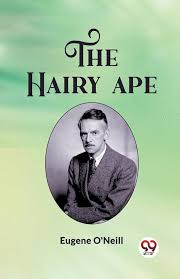
Hairy Ape
Hairy Ape was published in 1921 and premiered in 1922 by the American Playwright, Eugene O’Neill. It is a masterpiece of American Literature and finds its place in the literary periods associated with Expressionism and Realism. It implores the themes of Alienation, Oppression, Exploitation and Human Rights Violations of the working class. Their pangs are revealed through Yank, the protagonist and a stoker on a transatlantic liner. O’Neill depicts Yank’s journey from a promethean figure to a human gorilla in the monkey house. The play revolves around Yank’s quest for acceptance in a society ruled by capitalists. It is an exceptional piece of literature for readers of Modern Literature, Theatre Enthusiasts, Labor Rights Activists, and Historians of Industrialisation. The genre of the play is ‘Expressionist Drama.’ It is an amalgamation of Modern Theatre and Social Critique and focuses on themes of Class Struggle and Identity.
Content Outline
The Hairy Ape exemplifies brilliant psychological insights enveloped in an eight-scene play. It builds the narrative upon Yank’s debilitating self-awareness and the disillusionment that ensnares him. It depicts a poignant account of his struggles with distinct settings and episodes that peel layers of his psychological turmoil and the ensuing theme of alienation.
- Scene 1: Eugene O’Neill commences the play with a representation of the brutish lives of the stokers, their camaraderie and absence of rationality. Yank is a full-blooded seaman and takes pride in his identity. Paddy gets nostalgic and mourns the loss of human dignity.
- Scene 2: The daughter of a wealthy steel magnate named Mildred, finds discontentment in her opulence and yearns to know about the lives of the poor.
- Scene 3: In the stokehole, Yank and the stokers work amidst sweltering heat. When Mildred appears in this grim underworld, she gets horrified by Yank’s gloomy appearance. She calls him a ‘Hairy Ape’ and swoons.
- Scene 4: In the forecastle, Yank’s alienation heightens as his coworkers ridicule his appearance and emotions. He becomes enraged at Mildred’s insults and vows revenge but his peers restrain him.
- Scene 5: Three weeks later, Yank and Long visit the Fifth Avenue where Yank is a misfit. Smytten with jealousy, Yank becomes aggressive and attacks a wealthy man but is quickly subdued by the police.
- Scene 6: The following night, Yank sits in jail and introspects on his plight. He learns about the IWW from fellow prisoners and becomes intrigued by the idea of destruction and revolution. He bends the bars of his cell and gets out.
- Scene 7: A month later, Yank visits an IWW office. He misinterprets their objectives and reveals his desire to blow up Nazareth Steel. The members dismiss him and mock him as a “Brainless Ape.” His illusions collide with ridicule.
- Scene 8: Yank visits the zoo and identifies with a caged gorilla. He feels they share a bond as outcasts. After freeing the gorilla, he is crushed in its embrace and dies in the cage.
Analysis
- Focus Areas: In a world moving ahead at a breakneck speed with little care for the meek, the play explores the themes of Alienation, Identity, with a focus on the Human Rights Violations within Industrial Capitalism. Yank’s self-belief goes for a toss when Mildred calls him a “Hairy Ape”. This mockery tempts him to confront his alienation. The play is a piercing reminder of the dehumanizing effects of industrialisation on laborers which strip off their dignity and reduce them to mere cogs in a machine. Yank is blind to his exploitation and believes that his physical strength gives him worth. Long attempts to show him the oppressive nature of capitalism. This reflects a comprehensive theme of human rights violations, where the labor class is devoid of basic rights like fair wages, safe working conditions, and respect. Yank’s alienation highlights the absence of worker rights and the lack of recognition of humanity for laborers. His inability to find a place where he belongs underscores a fundamental violation of his Right to Dignity and Equality. O’Neill portrays how, in the early 20th century, labourers like Yank were deprived of basic human rights.
- Critique: The play is made worth reading by its focus on the derailing impact of Industrial Capitalism. The paucity of rights to people like Yank affects their dignity and self-determination. Its focus on alienation brings to the table the psychological toll of being reduced to a mere laborer and reflects the dearth of Socio-Economic Rights available to them. O’Neill’s expressionist techniques serve to emphasize the brutal realities of exploitation and oppression. While it sheds light on the violation of human rights, its portrayal of the working class as unintelligent and animalistic undermines its human rights message. The play’s fatalistic tone and Yank’s ultimate demise suggests that there is no escape from oppression. This curtails its potential as a call for action for human rights reforms. By focusing on Yank’s personal downfall rather than collective efforts to improve labor rights, O’Neill misses an opportunity to advocate for systemic change.
Overall Evaluation
The play is a compelling journey of class conflict, self-discovery and social rights. The work presents considerable complexity in its depiction of the negative effects of industrialization, and is an exceptional piece of literature for enthusiasts of Social Justice and Labor Relations. While the themes are timeless, the exaggerated characters and expressionist style may limit its appeal to readers unfamiliar with abstract drama. However, O’Neill’s critique of class inequality remains accurate and thought-provoking.
The writing is accessible, though the heavy dialect used in Yank’s dialogue may present challenges for some readers. The short length of the play makes it an easy read but its philosophical nature might require deeper reflection. At an affordable price, ‘The Hairy Ape’ offers great value, particularly for students of literature, drama enthusiasts, and those exploring socio-economic themes. I recommend it for readers interested in Classic American Theatre and Critiques of Capitalism.
By: Ananya Sharma
Write and Win: Participate in Creative writing Contest & International Essay Contest and win fabulous prizes.


